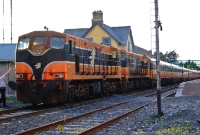141 Class
Built: 1962 by GM, La Grange Illinois works USA.
37 of these Bo-Bo locomotives were delivered to CIE in 1962 following the success of the 121 Class, and were also designated as the B Class. The 141s also carried the then new black & tan livery on delivery.
The 141 Class is basically a double cab version of the earlier 121 Class, and this made them a lot more versatile. The 141s could also work in multiple within its own class and later with other GM locos such as the later batch of 181 Class locos.
The 141s worked all over the Irish Rail system and included services on the Dublin-Belfast 'Enterprise', and in later years worked Dublin suburban trains from Maynooth, Arklow and Drogheda. Their last passengers duties were on cross country services. The few remaining 141s are employed in shunting duties at Inchicore, Dublin. Four locos have been preserved with Nos.141 & 142 restored to their original 1960s livery by the RPSI.
Max Speed: 80mph Weight: 67tons Length:13.42
Fitted for multiple operation with other GM locos (121+181)
37 of these Bo-Bo locomotives were delivered to CIE in 1962 following the success of the 121 Class, and were also designated as the B Class. The 141s also carried the then new black & tan livery on delivery.
The 141 Class is basically a double cab version of the earlier 121 Class, and this made them a lot more versatile. The 141s could also work in multiple within its own class and later with other GM locos such as the later batch of 181 Class locos.
The 141s worked all over the Irish Rail system and included services on the Dublin-Belfast 'Enterprise', and in later years worked Dublin suburban trains from Maynooth, Arklow and Drogheda. Their last passengers duties were on cross country services. The few remaining 141s are employed in shunting duties at Inchicore, Dublin. Four locos have been preserved with Nos.141 & 142 restored to their original 1960s livery by the RPSI.
Max Speed: 80mph Weight: 67tons Length:13.42
Fitted for multiple operation with other GM locos (121+181)


















































































